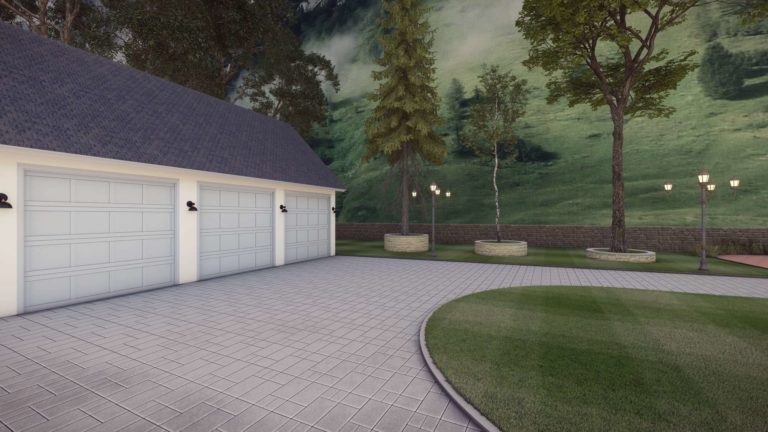When it comes to creating sustainable landscapes, it’s not just about choosing the right plants and shrubs or focusing on water conservation. Hardscaping—the non-living elements of a landscape—plays a crucial role in designing an eco-friendly outdoor space. From stainless drain grates to permeable paving, incorporating sustainable hardscape materials and techniques can significantly reduce the environmental impact of your landscaping project.
This article explores the various ways to achieve a greener future through hardscaping and sustainable landscape design.
Hardscaping Materials: Sustainable Options
One of the key factors in creating a sustainable landscape is the choice of hardscape materials. To minimise the environmental impact, consider using locally sourced, recycled or reclaimed materials. These options reduce the carbon footprint associated with transportation and help conserve natural resources.
1. Permeable Paving: A great way to reduce water runoff and promote infiltration, permeable paving allows rainwater to seep through the surface and into the ground. This helps replenish groundwater levels and prevents erosion. Some popular permeable paving options include porous concrete, permeable pavers, and resin-bound gravel.
2. Reclaimed or Recycled Materials: Using reclaimed or recycled materials such as bricks, concrete, and timber not only reduces the demand for new resources but also adds a unique, rustic charm to your landscape. These materials can create retaining walls, pathways, and patios.
3. Locally Sourced Materials: Choosing locally sourced materials like stone, timber, or gravel can significantly reduce the carbon footprint associated with transportation. Moreover, these materials often blend seamlessly with the surrounding environment, creating a more natural look.
Sustainable Drainage Solutions
An essential aspect of sustainable landscape design is effective water management. By incorporating proper drainage, you can prevent waterlogging, soil erosion and minimise the risk of flooding. Below are some sustainable drainage solutions to consider:
1. Stainless Steel Drainage Grates: A popular choice for modern landscapes, stainless steel drainage grates offer superior durability, corrosion resistance, and aesthetic appeal. As a material, stainless steel is also environmentally friendly, as it is 100% recyclable and has a relatively low carbon footprint. A stainless steel drainage grate can be used in various applications, including driveways, patios, pool surrounds, and walkways.
2. Swales and Rain Gardens: Shallow, vegetated channels that help slow down and filter stormwater runoff. Rain gardens are shallow depressions filled with water-tolerant plants designed to capture and infiltrate rainwater. Both these features help in reducing water pollution and replenishing groundwater levels.
3. Green Roofs: Green roofs are covered with vegetation, which provides insulation, reduces energy consumption, and helps manage stormwater runoff. The plants on green roofs absorb rainwater, reducing the volume and rate of runoff.
Incorporating Stainless Steel Drain Grates into Your Hardscape Design
Consider incorporating stainless steel drain grates in your sustainable landscape design when planning your hardscape project. Here are some tips for successfully integrating these drains into your outdoor space:
1. Assess Your Site’s Drainage Needs: Determine the areas in your landscape that require effective drainage solutions, such as patios, walkways, driveways, and pool surrounds. When selecting the appropriate stainless steel drain, consider slope, soil type, and existing drainage systems.
2. Choose the Right Drain Style and Size: Stainless steel drains come in various styles, including linear gutters, point drains and slot drains. Consider the specific requirements of your project and select the ideal type and size of drain to suit your needs.
3. Consider Customisation Options: If your hardscape project has unique requirements or site conditions, consider working with a manufacturer that offers customisation options for stainless steel drains. This will ensure that your drainage system is tailored to your specific needs.
4. Work with a Professional: To achieve the best results for your hardscape project, consider working with a professional landscape designer or contractor with experience in sustainable landscape design and installing stainless steel drainage systems.
Conclusion
Incorporating sustainable practices into hardscape designs is essential in creating beautiful, functional and environmentally responsible outdoor spaces. By selecting sustainable materials and efficient drainage solutions, such as stainless steel drain grates, we can minimise our impact on the environment and create outdoor spaces that are both aesthetically pleasing and practical. So, when planning your next hardscape project, consider the benefits of stainless steel drains and their role in sustainable landscape design.
Looking for reliable stainless steel drainage solutions? Contact Yeti Civil Products today and get the best possible solutions for your project. Whether you need a standard system or a custom-made solution, our team of experts will provide you with the best possible advice and service. Experience the difference in quality and reliability with our premium stainless steel products. Contact us today to get started!

